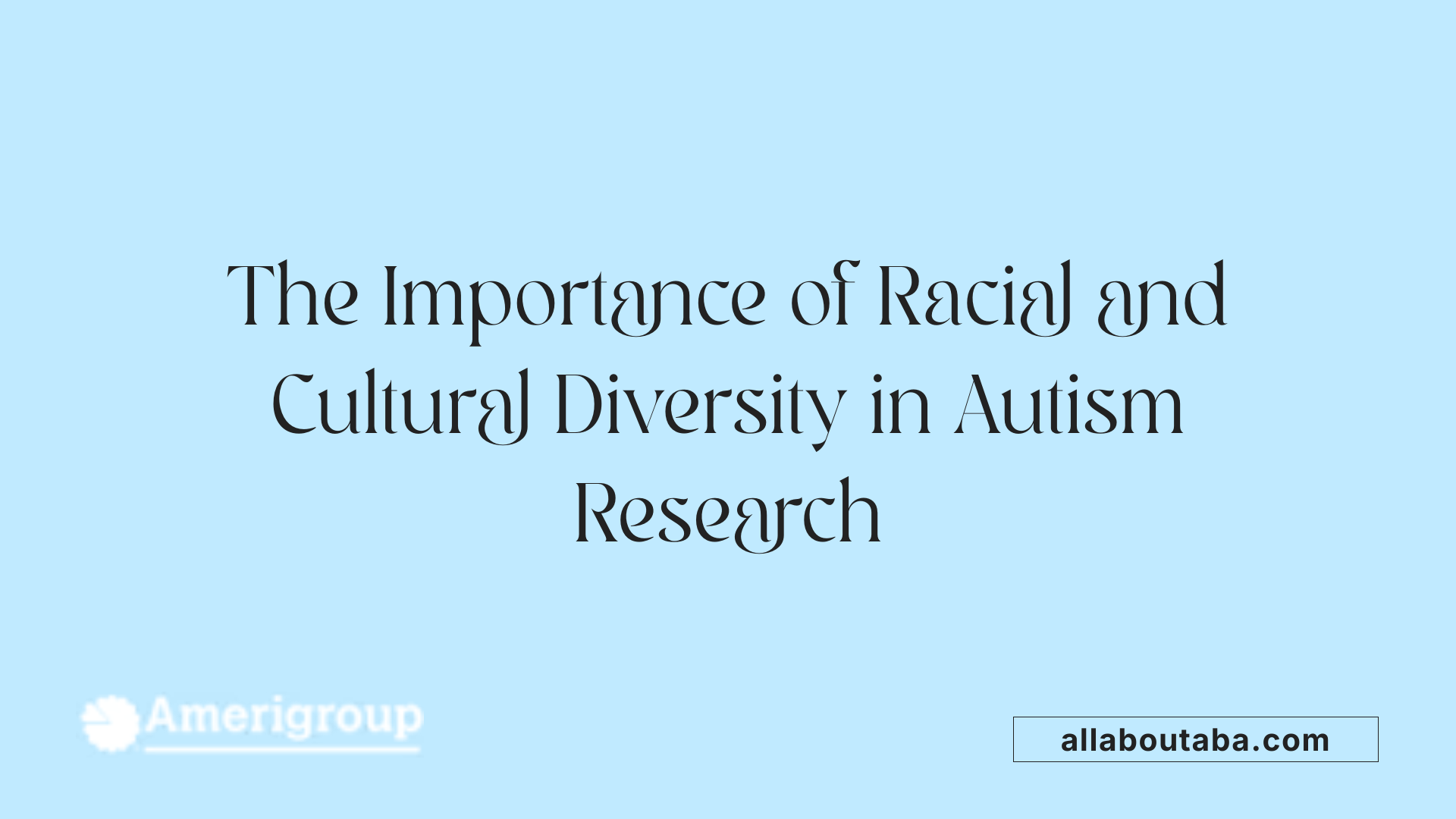Cultural Perspectives On Autism Around The World
Understanding Autism Therapy Within Diverse Cultural Frameworks
Autism spectrum disorder (ASD) is recognized worldwide, yet cultural perspectives and approaches to treatment vary significantly. Applied Behavior Analysis (ABA) therapy stands as a widely endorsed intervention for autism, but how it is delivered and adapted across different cultures raises important questions about inclusivity, efficacy, and accessibility. This article explores cultural considerations in autism therapy around the world, examining research diversity, therapy provision, adaptations, and challenges faced by minority populations.
What Is Applied Behavior Analysis (ABA) Therapy?

How well is participant ethnicity represented in social skills intervention studies for ASD?
Since 2010, approximately 62% of social skills intervention studies for individuals with Autism Spectrum Disorder (ASD) have reported data on participant race, ethnicity, or nationality. This suggests a growing awareness of the importance of demographic reporting in autism research, though a substantial portion of studies still omit this information.
Are minority populations adequately represented in ASD research?
Research conducted in the United States has highlighted an ongoing issue with underrepresentation of minority populations in autism studies. This imbalance points to a need for more inclusive recruitment strategies and efforts to ensure research samples better reflect the diversity of the population.
Are cultural adaptations commonly used in social skills interventions for ASD?
Few studies explicitly mention using cultural adaptation practices in social skills interventions for ASD. This indicates a considerable gap in the consideration of cultural factors that could influence intervention acceptability and effectiveness among diverse groups.
What promising strategies exist for culturally adapting social skills interventions?
Some emerging research has identified strategies to culturally adapt these interventions successfully. These include both surface-level adaptations, such as modifying materials and language, and deep-structure adaptations, which consider cultural values, beliefs, and social norms. Incorporating these adaptations may enhance engagement and outcomes across different populations.
Why is increased diversity and cultural adaptation important in ASD research?
The systematic review emphasizes the necessity of increasing diversity in ASD research samples. It also suggests that integrating culturally adapted approaches into social skills interventions may boost their effectiveness, helping to address the unique needs of diverse communities affected by autism.
Providers of ABA Therapy: Professionals and Organizations

What types of companies and professionals provide ABA therapy for autism?
ABA therapy is delivered by a variety of specialized providers and professionals who focus on behavioral intervention. The primary providers include Board Certified Behavior Analysts (BCBAs), behavior therapists, and clinical psychologists trained in ABA techniques. These experts work in settings ranging from small individual clinics to large treatment centers dedicated to serving children with autism spectrum disorder (ASD) and other developmental conditions.
Settings and providers
ABA therapy companies may operate locally or nationally, often tailoring their services to meet client needs. These organizations vary in size and scope, from solo practices to large multidisciplinary centers offering comprehensive developmental services. The therapy is usually integrated into diverse environments such as clinics, schools, and sometimes even home settings, ensuring flexibility and accessibility.
Range of disorders addressed by ABA
While ABA is best known for its effectiveness in autism, it is also employed to address behavioral challenges related to other disorders, such as brain injury, attention deficit hyperactivity disorder (ADHD), obsessive-compulsive disorder (OCD), and post-traumatic stress disorder (PTSD). Across these conditions, the focus remains on developing functional skills and managing behaviors that impact daily life.
Family involvement and training
A critical component of ABA therapy is family involvement. Providers frequently offer training to parents and caregivers to equip them with ABA strategies. This training supports the continuation of therapy goals outside clinical settings, encouraging skill generalization and consistent progress in everyday environments. Families become active participants in supporting the individual's growth and development through this collaborative approach.
Benefits and Challenges of ABA Therapy Across Diverse Cultural Contexts

What are the benefits and challenges associated with ABA therapy for individuals with autism?
ABA (Applied Behavior Analysis) therapy brings substantial benefits for individuals with autism by improving communication skills, enhancing social abilities, promoting greater independence, and reducing harmful behaviors. These gains help individuals engage more fully in community and social settings.
Modern ABA techniques are often naturalistic and play-based, tailored to the individual's interests and strengths. This approach helps encourage engagement and joy rather than enforcing conformity, making therapy more effective and meaningful.
Despite its benefits, ABA therapy also presents challenges. The therapy often requires intense and lengthy sessions, which can place a significant burden on families and caregivers. Additionally, individual responses to ABA vary widely, meaning what works for one person may not work for another.
Access to ABA therapy can be limited by the need for specially trained professionals and variability in insurance coverage or provider availability. These resource considerations affect who can benefit from the therapy.
Why is culturally sensitive ABA therapy important?
Research shows that autism intervention studies often underrepresent minority populations, particularly in the United States. Moreover, few studies report adapting social skills interventions to fit different cultural backgrounds, missing an important opportunity.
Incorporating culturally sensitive practices into ABA therapy is crucial to make interventions more effective across diverse populations. Some approaches include surface-level adaptations, such as language translation, and deeper structural modifications that honor cultural values and social norms.
Such culturally tailored interventions can reduce barriers to access and improve engagement among diverse families, ensuring that more individuals receive the full benefits of ABA.
How can resource availability and access affect ABA therapy?
Availability of resources like trained therapists and insurance coverage can vary depending on location and demographics, often limiting access for minority groups. Increasing diversity in research and clinical practice can help address disparities and promote equitable access to high-quality autism care.
In summary, ABA therapy offers meaningful benefits but must be delivered with attention to intensity demands, individual variability, and cultural sensitivity to maximize positive outcomes for all individuals with autism.
Cultural Representation and Diversity in Autism Research

How does cultural diversity feature in autism research studies?
Research shows that 62% of social skills intervention studies for individuals with Autism Spectrum Disorder (ASD) report participant ethnicity, race, or nationality since 2010. This indicates a growing awareness of the importance of including demographic data in autism research to better understand differences across populations.
Underrepresentation of minorities in the United States
Despite increased reporting, many studies conducted in the United States still underrepresent minority groups. This lack of representation highlights a persistent challenge in autism research regarding diversity and equity. Minority populations often receive less attention in research samples, which can limit the generalizability of findings.
Implications for autism interventions globally
Underrepresentation and insufficient cultural adaptation in studies mean the effectiveness of social skills interventions might not fully extend to diverse populations globally. Few studies explicitly mention cultural adaptation practices, creating a gap in tailored interventions that address cultural differences.
Need for increased diversity in studies
The systematic review urges the autism research community to improve diversity in study samples and integrate cultural adaptations into social skills interventions. Incorporating both surface-level and deep-structure cultural modifications shows promising potential to enhance intervention effectiveness across various populations.
| Aspect | Current Status | Implication |
|---|---|---|
| Ethnicity Reporting | 62% of studies include participant ethnicity info | Helps identify population diversity |
| Minority Representation in US | Often underrepresented | Limits generalizability and equity |
| Cultural Adaptations in Interventions | Few studies report cultural tailoring | Misses opportunity to improve intervention outcomes |
| Recommendations | Increase diversity and cultural adaptation efforts | Enhance relevance and efficacy of interventions |
The Importance of Cultural Adaptations in Autism Interventions

What role do cultural adaptations play in social skills interventions for autism?
Despite increased representation of participant ethnicity in autism research since 2010, there remains a notable lack of cultural adaptation in social skills interventions for individuals with ASD. Few studies explicitly describe using cultural tailoring, which suggests a significant gap in addressing the diverse needs of different populations.
What types of cultural adaptations have been identified?
Research highlights two main types of cultural adaptations:
- Surface-level adaptations: These involve modifying language, visuals, and materials to better reflect the participant's culture.
- Deep-structure adaptations: These address underlying cultural values, beliefs, and social norms that influence behavior and communication styles.
Both adaptations aim to make interventions more culturally relevant and acceptable.
What promising strategies exist for cultural adaptation?
Some studies have developed and tested methods for tailoring social skills interventions to diverse cultural contexts. Strategies include:
- Using culturally familiar scenarios and role-plays in sessions.
- Incorporating family and community norms into the curriculum.
- Adjusting teaching techniques to align with culturally preferred communication styles.
These approaches have shown potential in enhancing engagement and outcomes in underrepresented groups.
How might cultural adaptations improve intervention effectiveness globally?
Culturally adapted interventions can increase the relevance and acceptability of social skills training, making it more effective across different populations. Systematic reviews call for greater diversity in ASD research and underscore that integrating cultural sensitivity can lead to better social and developmental outcomes worldwide. This approach helps close gaps caused by the underrepresentation of minority groups in autism studies, particularly in the United States.
By embracing both surface-level and deep-structure adaptations, practitioners can design more inclusive programs that respect and harness cultural differences, ultimately improving the global reach and success of autism social skills interventions.
Toward Inclusive and Effective Autism Therapies Globally
As autism continues to be recognized globally, the intersection of culture and therapy becomes increasingly significant. Applied Behavior Analysis remains a cornerstone of autism intervention, but its global impact depends on acknowledging cultural diversity in research and practice. Greater inclusion of minority populations in autism studies and the integration of cultural adaptations into therapy design are essential steps toward interventions that are both effective and respectful of cultural differences. By bridging cultural perspectives, the autism community worldwide can move toward more inclusive, accessible, and personalized care that reflects the rich diversity of human experience.
References
Other articles
Recent articles

Cultural Perspectives On Autism Around The World

Autism And Creative Arts As Emotional Expression Tools

Developing Emotional Regulation Skills In Autistic Teens

Best Sensory-Friendly Lighting Solutions For Autism

Cognitive Behavioral Therapy Adaptations For Autism

Best Practices For Autism-Friendly Movie Screenings

Autism And Eating Challenges Beyond Picky Eating

Best Practices For Autism-Friendly Public Transport Design

Best Ways To Foster Collaboration Between Parents And Schools For Autism Support

Supporting Autistic Children During Transitions Between Activities

The Role Of Teachers In Fostering Autism Peer Acceptance

Using Art Therapy To Support Children With Autism

Autism And Strategies For Addressing Sensory Defensiveness

Autism And The Benefits Of Structured Leisure Activities

How To Support Autistic Students During Exam Season

Autism And Goal Setting For Personal Growth

How To Use Gamification In Autism Learning Programs

How Schools Can Reduce Bullying Of Autistic Students

Early Intervention Strategies For Autism Spectrum Disorder

The Role Of Therapists In Autism Life Skills Coaching

How To Support Autistic Individuals In Crisis Situations

Autism And Self-Care Routines For Stress Management

Understanding Echolalia And Its Role In Autism Communication

Autism And Fine Arts Education Benefits

The Impact Of Multisensory Learning On Autism Education

How Family Counseling Supports Autism Household Dynamics

Best Practices For Inclusive Playgrounds For Autism

Best Practices For Autism-Friendly Shopping Centers

How Autism Affects Fine Motor Skill Development

Best Ways To Introduce Sensory Activities Into Daily Routines

How Sports Teams Can Be Inclusive Of Autistic Players

Autism And Strategies For Building Workplace Resilience

Autism And The Impact Of Hormonal Changes During Puberty

How To Support Autistic Students In Foreign Language Classes

Best Ways To Teach Money Skills To Teens With Autism

Supporting Siblings Of Children With Autism

Autism And Co-Occurring Gastrointestinal Disorders

The Role Of Art Projects In Autism Sensory Integration

How Schools Can Incorporate Sensory Break Spaces

Best Practices For Autism Sensory Regulation At School

Autism And Strategies For Teaching Organizational Skills

Understanding The Relationship Between Autism And Anxiety Disorders

Autism And Life Planning For Long-Term Care

Exploring Visual Supports In Autism Education

Ways To Encourage Social Interaction In Children With Autism

The Connection Between Autism And Dyscalculia

The Role Of Occupational Therapy In Transition Planning For Autism

The Role Of Physical Therapists In Autism Motor Skills Support

How To Teach Decision-Making Skills To Autistic Young Adults

The Connection Between Autism And Epilepsy

Best Practices For Transitioning Autistic Children Into New Schools

Autism And Time Management Challenges In Adulthood

The Role Of Visual Arts In Autism Communication Development

How To Address Tactile Defensiveness In Autism

Best Practices For Telehealth Autism Therapy

How To Help Autistic Children Develop Friendship Skills

How Schools Can Support Autistic Students In Career Prep

Best Strategies For Autism-Friendly Event Planning

Understanding Noncontingent Reinforcement In Autism Behavior Plans

How Drama Therapy Benefits Autistic Individuals

Best Practices For Autism-Friendly Fitness And Recreation Centers

Best Ways To Promote Healthy Social Media Use For Autistic Teens

How To Help Autistic Children Cope With Public Speaking

Autism And Strategies For Managing Unexpected Changes

Best Podcasts About Autism For Parents And Educators

Autism And The Impact Of Seasonal Changes On Behavior

The Role Of Diet In Managing Co-Occurring Conditions With Autism

Sleep Challenges In Autism And Practical Solutions

Best Ways To Build Daily Routines For Autistic Children

Best Practices For Supporting Autistic Entrepreneurs

Autism And Strategies For Navigating Large Social Gatherings

Adaptive Sports And Recreational Activities For People With Autism

Autism And The Benefits Of Story-Based Learning Activities

Understanding The Role Of Play In Autism Development

Autism And The Impact Of Environmental Noise On Learning

How To Create Autism-Friendly Community Spaces

Autism And Chronic Health Conditions: What To Know

The Role Of Care Managers In Autism Life Planning

How To Teach Social Boundaries To Autistic Children

How Autistic Individuals Experience Empathy Differently

How To Support Autistic Employees In Remote Work Settings

Autism And The Relationship Between Motor Skills And Learning

How To Create Community Resource Guides For Autism Families

How To Teach Daily Living Skills To Autistic Teens

Autism And The Impact Of Mind-Body Practices On Stress Reduction

Autism And The Benefits Of Outdoor Group Activities

How To Create Autism-Friendly Sensory Paths In Schools

Best Practices For Autism-Friendly Park And Recreation Areas

Autism And Strategies For Reducing School Refusal

Supporting Autistic Individuals In Public Speaking

The Role Of Diet In Managing Autism Symptoms

The Benefits Of Gardening Clubs For Autism Social Development

How To Prepare Autistic Children For Dental Visits

Autism And Employment: Career Paths That Work

Best Practices For Autism-Friendly Hotels And Lodging

The Impact Of Screen Time On Autism Development

Autism Screening Tools For Early Childhood

The Role Of Physical Exercise In Autism Therapy

Best Strategies For Supporting Autistic College Students

The Role Of Technology In Autism Early Detection
We’re All About You, Your Family, and Your Child

